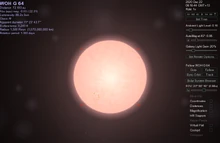
WOH G64 is a big old red hypergiant star.
Properties
WOH G64 is classified as a red hypergiant, though it should look orange to our eyes due to red not being a "hot" colour. If we could see the star at all. It is way too far away to be seen. It's in the Large Magellanic Cloud, another galaxy. Yet now we know quite a bit about this star. WOH G64's stellar wind and low density has made a massive donut-shaped cloud that weighs in at 6.25x the weight of our Sun and 0.4744 light-years across. It may be great for forming planets, but no planet has been discovered. If a planet gets discovered and confirmed, WOH G64 may possibly be the first supergiant star with planets! However, the chances of planets is very slim, so don't get your hopes high. But if there were planets, they would have to be 750 ly away to be habitable! WOH G64 is the largest star in the Large Magellanic Cloud, but not the largest in the Universe because UY Scuti, VV Cephei A, and VY Canis Majoris are larger. You may be thinking, "WOH, it's a huge star!". But that's not how it got it's name. It was named after it's three discoverers who discovered it in the '70s, Westerlund, Olander and Hedin. But yeah, it's a big star. About 1,540 to 2,000x larger than the Sun. That mean it should take 835 years, 173 days, 19 hours, 3 min, and 6.6 s for a Boeing 747 to circle it once. It would also take light 11 min, 54.4 s to go across WOH's face. But you'd burn immediately on the 3,200 degree surface. Also, it'll take you sometime to fall on WOH G64. It'll take you approximately 1.498 s just to fall one metre. For comparison, it'll take approximately 0.452 s here on Earth, to fall 1 m. Anyway, WOH G64 was originally thought to be 40x the Mass of the Sun (which is nearly 2 nonillion kg), but further research has cut down over half it's weight. Very Sadly though, it may die as a supernova thousands to tens of thousands of years from now. The supernova should have a peak magnitude of +2.9, brighter than the brightest star, but not as bright as Venus. But since it is 163,000 ly away from us, we are seeing it from 163,000 years ago. So it may already be dead now. Rest in Peace. :¦⁻( It is losing weight and has already lost 32.89% of it's original weight from shedding the half-light-year cloud. There is the possibility of WOH G64 being a binary system, but we will never know.
| Radius | 1,072,366,680 km
(once 1,392,784,000 km) |
|---|---|
| Temperature | 3,227 °C |
| Mass | 19x Sun |
| Spectral type | M5 Ia |
| Apparent Magnitude | +18.46 |
| Gravity | 0.8913 m/s2 |
| Constellation | Dorado |